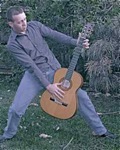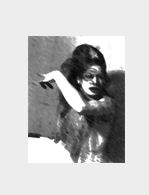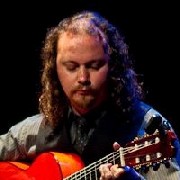Welcome to one of the most active flamenco sites on the Internet. Guests can read most posts but if you want to participate click here to register.
This site is dedicated to the memory of Paco de Lucía, Ron Mitchell, Guy Williams, Linda Elvira, Philip John Lee, Craig Eros, Ben Woods, David Serva and Tom Blackshear who went ahead of us.
We receive 12,200 visitors a month from 200 countries and 1.7 million page impressions a year. To advertise on this site please contact us.
|

|
|
RE: Great Grand Daddy of Flamenco
|
You are logged in as Guest
|
|
Users viewing this topic: none
|
|
Login  | |
|

   
estebanana
Posts: 9352
Joined: Oct. 16 2009

|
 RE: Great Grand Daddy of Flamenco (in reply to Kevin) RE: Great Grand Daddy of Flamenco (in reply to Kevin)
|
|
|
quote:
The author of this article suggests that the last polyphonic work to be published was Fuenllana in 1554. Bermudo calls strummed guitar musica golpeada around mid-century so the strummed style possibly existed about forty years before Amat's treatise.
In my opinion Bermudo was more of an authority than Amat. Bermudo was a very learned man and way ahead of this time. Bermudo expressed that he favored equal temperament over various other scale tempering systems like Gerle, half comma, whatever in 1550...ok it took the rest of Europe 300 more years to fully embrace that idea.
He also reported on the strumming of the guitar in his 1550 treatise On Playing the Vihuela, so I doubt he was talking out of speculation, he had been there and seen it. And if he mentioned it in 1550 it must have been around for some time before that so that the technique had a history and was therefore worth noting.
So anyway, I'm not being weird, but when you said categorically Renaissance players did not strum they plucked....that seems to petty right, to call you out on that, but it is a big deal in understanding early music.
As far as Fuenllana being the last one to compose with polyphony or entabulate for vihuela I think that is not quite true or an absolute. There is a slippery slope, at least for me, between species counterpoint and older vocal polyphony and they way it all developed into continuo and baroque counterpoint. There were vihuela playing hold overs into the very beginning of the 17th century, but by that time it had already bloomed and faded away. others have said by about 1585 it was done. I think calling the vihuela game as early as 1554 is premature.
Another thing to understand as you read Bermudo is that entabulation is not a composition method or style per se, it is basically a method of arranging pre existing polyphonic compositions to be played on a vihuela. That is why Bermudo goes into great detail on how to construct this or that vihuela stringing and tuning.
To back up, those of you who don't know what vocal polyphony is should get a leg up on what we're talking about. Vocal polyphony is a kind of composition written in parts that is sung by a group. It comes out of late middle ages church music and has roots in older music like Byzantine chant. ( which can be quite modern sounding and dissonant).
What the vihuela players were doing when they entabulated a piece of vocal polyphony is they arranged these vocal parts, usually four or five, but sometimes two or three, to be played by one person on the vihuela. In the late 1400 to mid 1500's this was a practice that was in vouge in the courts of Spain and Italy and in any houses where the owners had enough money to engage in advanced music training. Juana la Loca one of the royal family of Spain in the late 1400's was said to have only been at peace when she listened her vihuelist play. The music was often taken from liturgical music that was Christian and much of it came from Northern composers from Holland.
So Bermudo spends most of his treatise explaining how to arrange this music taking it from vocal lines sung by four persons and basically compressing it so the separate voices can be played by one person on one instrument. So that is what is so compelling about the vihuela because it was one of the first instruments, along with Renaissance lute, in which a single person could play multiple harmonized lines of music. There were books of entabulations compiled by different vihulelists and these could be purchased by those with enough money. They were really the jazz fake books of the day. However it was costly past time and usually only the rich engaged in this form of music as far as we know to date.
The excitement that one could play all these vocal lines at once by ones self is the kind of excitement that spurred Beethoven a few hundred years later to say of the guitar in Fernando Sor's era that it was like "a little orchestra of its own". This idea of a self contained little orchestra was realized in the vihuela and that is why it's important in the development of the guitar.
_____________________________
https://www.stephenfaulkguitars.com
|
|
|
|
REPORT THIS POST AS INAPPROPRIATE |
Date Dec. 31 2012 1:40:47
 |
|

   
estebanana
Posts: 9352
Joined: Oct. 16 2009

|
 RE: Great Grand Daddy of Flamenco (in reply to Pimientito) RE: Great Grand Daddy of Flamenco (in reply to Pimientito)
|
|
|
quote:
Im not sure where you got the idea that Vihuelas werent strummed. Maybe there is no written melodic score with strumming but string instruments such as vihuela provide the rhythmic background for forms such as folias de España as well as many dances or the early renaissance.
Jordi Savall is my favorite interpreter of music from this period (and his gorgeous daughter playing harp) Check out his vihuela backing here (4.34 and 6.30)
Lislevand is not playing Vihuela in this piece, he's playing baroque guitar. But this piece is an example of what I as talking about much earier in the conversation. It's not Renaissance polyphony, it's based in rhythmic cells and modal melody lines and it probably really late Renaissance to early 17th century.
Just to say it once more, I'm not trying to connect flamenco to these earlier forms. I'm simply talking about these forms an trying to parse out what some of it means an how it worked. Ricardo is kind of taking the piss out when he asks that quesiton because he knows full well that I know that he knows, that I know, that he knows there is no linear and literal answer.
I'll dare say also that when I cited Juan Bermudo, I did not have to go look him up on the internet. I merely reached up above the computer and pulled down my copy De Tan˜er Vihuela published in Osuna in 1550 that has been there for more than 15 years.
So there.
I'm just saying I researched fairly deeply into this material over a period of years and it began as a quest to find the origins of the guitar starting for me in the early 1980's. I read all the book available about the history of classical guitar and they all pointed back to the famous Andre' Jacquemart Vihuela as the only extant instrument that could be called a vihuela. Eventually through the years I made contacts and found articles, because it was still and area about which very little was known, and gleaned little by little what this vihulea stuff was all about. Sometime in the late 1990's I found a lute maker who had been making historical reproductions of the vihuela based on all the current research and iconographic evidence. He taught all the requisite details and gave me all the points to research to understand how to think about building historical reproductions fro this time period.
Eventually I dropped out of the whole flamenco scene for 6 or 8 months and spent all my free time researching this Renaissance stuff in the UC Berkeley music library and making trips to see the lute maker to talk about what I found. He did not really spoon feed the information he made me go out an get it and then we talked about it.
I ended up making three vihuelas, studying the vihuela and making a renaissance guitar. Which isn't much really, but it did serve to give me an insight to how people like Rolf Lislevand perform. Eventually I got sucked back into flamenco and the guys asked me where I had been all those months. I started talking about the vihuela and their eyes glazed over as if I were talking about how to make Venetian blinds out of recycled milk cartons.
But it was much more than a side trip, I stayed on reading and listening in secret. The Renaissance is really more complicated and variable from year to year in styles and regions. It's as contradictory and complex as any other period in music. Two things existed at the same time for different reasons. One of those things was plucking and strumming. But each fits into highly specialized areas. What started this off was that Kevin said in kind of sweeping gestural statement that renaissance players did not strum, they plucked. They also did not have "chords". Both of those statements has two sides or more, because depending on the instrumentation and the music plucking or strumming may be a better way to play it.
I'm pretty sure when Kevin said categorically that there was only plucking and no strumming, I think he knew that there was some strumming, but was using hyberbole to make a point about the main thrust of Renaissance music as not having the simplified chord charts in Amats book. So the whole thing was really about two music nerds prodding one another over a very selective and minor point about when and where strumming and plucking occurred in the Quatro Cento.
If Kevin was trying to make any connection between Flamenco and Vihuela or Amat I totally distance myself from those claims. I distance myself on the grounds that I am innocent of any Crimes Against Flamenco and demand to be held innocent until proven guilty before a qualified jury of non guitar playing peers.
When I was in college we had one terrible teacher who had reputation for a temper. Dr. Saylor. Saylor was a very smart guy, he studied music in the best East Coast conservatories and in India and Europe. But he had his lighter side too. He was an expert on Bach. He knew so much about Bach that the joke in the music dept. was that Dr. Saylor could tell you the dates and times Bach went to the bathroom.
If only Dr. Saylor were here to tell us when precisely the first chord in flamenco was sounded and what that guitarist ate as a tapa with his beer after the show.

Happy New Year
_____________________________
https://www.stephenfaulkguitars.com
|
|
|
|
REPORT THIS POST AS INAPPROPRIATE |
Date Dec. 31 2012 20:41:03
 |
|

   
Kevin
Posts: 294
Joined: Sep. 7 2008

|
 RE: Great Grand Daddy of Flamenco (in reply to estebanana) RE: Great Grand Daddy of Flamenco (in reply to estebanana)
|
|
|
quote:
Just to say it once more, I'm not trying to connect flamenco to these earlier forms. I'm simply talking about these forms an trying to parse out what some of it means an how it worked. Ricardo is kind of taking the piss out when he asks that quesiton because he knows full well that I know that he knows, that I know, that he knows there is no linear and literal answer.
There are many linear as well as many "branched" answers and that is the whole point of scholarship; to try to disentangle these threads as new evidence/facts comes to light.
quote:
I'll dare say also that when I cited Juan Bermudo, I did not have to go look him up on the internet. I merely reached up above the computer and pulled down my copy De Tan˜er Vihuela published in Osuna in 1550 that has been there for more than 15 years.
So there.
Same for me except my sources are books by Amat and Hudson that I own as well as extensive time with Sanz and de Murcia and also several other primary and secondary sources including the ones I listed. This is why our perspectives are so different. You "know" Renaissance sources while I "know" Baroque sources that focus on the rasgueado style.
En garde. 
quote:
I started talking about the vihuela and their eyes glazed over as if I were talking about how to make Venetian blinds out of recycled milk cartons.
I am glad you know this stuff because I have the same problem. People's eyes glaze over or they change the subject. I love the guitar in all its forms but happen to have limited my focus to flamenco with a few classical pieces (so that degree doesn't go to waste lol).
quote:
The Renaissance is really more complicated and variable from year to year in styles and regions. It's as contradictory and complex as any other period in music. Two things existed at the same time for different reasons. One of those things was plucking and strumming. But each fits into highly specialized areas.
Agreed. Same goes for Baroque, or the cafe cantante flamenco period, or the nuevo or modern flamenco movement.
quote:
I'm pretty sure when Kevin said categorically that there was only plucking and no strumming, I think he knew that there was some strumming, but was using hyberbole to make a point about the main thrust of Renaissance music as not having the simplified chord charts in Amats book. So the whole thing was really about two music nerds prodding one another over a very selective and minor point about when and where strumming and plucking occurred in the Quatro Cento.
Nice summary.
One final note on Ricardo's question and your commentary on it. Although there is no evidence for a direct lineage, I think that it is safe to say that if you take the Rennaissance, the Baroque, or even someone like Arcas or Llobet out of the equation, flamenco guitar as we know it would not exist as it does. I think that that is a safe conclusion. So there is a linear descent, we just have not unraveled all the details. Perhaps we never will and we should just shut up and practice. However, I for one do find guitar history very interesting.
_____________________________
|
|
|
|
REPORT THIS POST AS INAPPROPRIATE |
Date Dec. 31 2012 21:30:35
 |
|
 New Messages New Messages |
 No New Messages No New Messages |
 Hot Topic w/ New Messages Hot Topic w/ New Messages |
 Hot Topic w/o New Messages Hot Topic w/o New Messages |
 Locked w/ New Messages Locked w/ New Messages |
 Locked w/o New Messages Locked w/o New Messages |
|
 Post New Thread
Post New Thread
 Reply to Message
Reply to Message
 Post New Poll
Post New Poll
 Submit Vote
Submit Vote
 Delete My Own Post
Delete My Own Post
 Delete My Own Thread
Delete My Own Thread
 Rate Posts
Rate Posts
|
|
|
Forum Software powered by ASP Playground Advanced Edition 2.0.5
Copyright © 2000 - 2003 ASPPlayground.NET |
0.15625 secs.
|


 Printable Version
Printable Version













 New Messages
New Messages No New Messages
No New Messages Hot Topic w/ New Messages
Hot Topic w/ New Messages Hot Topic w/o New Messages
Hot Topic w/o New Messages Locked w/ New Messages
Locked w/ New Messages Locked w/o New Messages
Locked w/o New Messages Post New Thread
Post New Thread